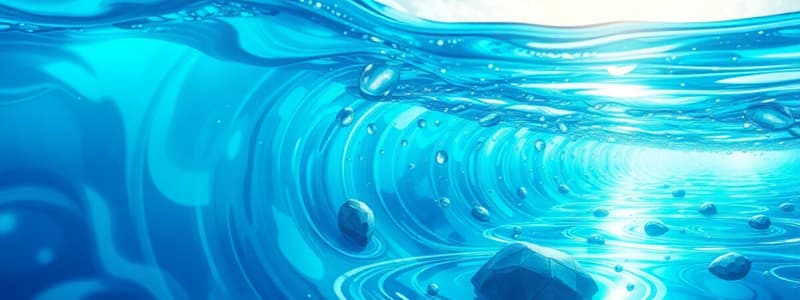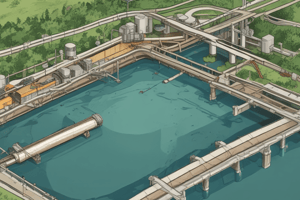Podcast
Questions and Answers
Which of the following best describes the composition of wastewater?
Which of the following best describes the composition of wastewater?
- 100% pure water, no other substances
- 99% inorganic compounds, 1% water and microorganisms
- 99.9% water, 0.1% organic matter, microorganisms, and inorganic compounds (correct)
- 99.9% organic matter, 0.1% water
The quality and quantity of effluent from an industry primarily depends on which combination of factors?
The quality and quantity of effluent from an industry primarily depends on which combination of factors?
- The nature of the industry, raw materials used, manufacturing process, and housekeeping practices. (correct)
- The amount of water available and local regulations.
- The age of the industrial equipment and the ambient temperature.
- The industry's location and number of employees.
What is indicated by high turbidity in a water sample?
What is indicated by high turbidity in a water sample?
- Presence of suspended materials that scatter or absorb light. (correct)
- Low levels of dissolved salts.
- Elevated levels of acidity.
- High concentration of dissolved oxygen.
What causes taste and odor in wastewater?
What causes taste and odor in wastewater?
The ability of water to neutralize acids is known as:
The ability of water to neutralize acids is known as:
What effect does a rise in water temperature typically have on aquatic ecosystems?
What effect does a rise in water temperature typically have on aquatic ecosystems?
In the context of self-purification of natural streams, what process replenishes dissolved oxygen after organic matter is stabilized?
In the context of self-purification of natural streams, what process replenishes dissolved oxygen after organic matter is stabilized?
Which of the following describes artificial methods of wastewater disposal?
Which of the following describes artificial methods of wastewater disposal?
Which aspect of growing populations poses a significant challenge to ensuring safe and sufficient water supplies?
Which aspect of growing populations poses a significant challenge to ensuring safe and sufficient water supplies?
What is the primary goal of adopting a more circular, sustainable economy in the context of wastewater management?
What is the primary goal of adopting a more circular, sustainable economy in the context of wastewater management?
How does the increased use of chemical fertilizers and pesticides in agriculture contribute to water pollution?
How does the increased use of chemical fertilizers and pesticides in agriculture contribute to water pollution?
What is identified as a major issue in poorer urban areas regarding wastewater management?
What is identified as a major issue in poorer urban areas regarding wastewater management?
Approximately what percentage of the Earth's surface is covered by water?
Approximately what percentage of the Earth's surface is covered by water?
Which of the following correctly describes the distribution of water on Earth?
Which of the following correctly describes the distribution of water on Earth?
Why is safely reusing wastewater considered grossly undervalued worldwide?
Why is safely reusing wastewater considered grossly undervalued worldwide?
How does household effluent contribute to environmental contamination in densely-populated areas?
How does household effluent contribute to environmental contamination in densely-populated areas?
Flashcards
Hydrological Cycle
Hydrological Cycle
The continuous movement of water on, above, and below the surface of the Earth.
Wastewater
Wastewater
Water that has been used and contaminated by human activities.
Wastewater Management
Wastewater Management
Managing wastewater to reduce pollution and enable reuse of resources.
Water Pollution
Water Pollution
Signup and view all the flashcards
Water
Water
Signup and view all the flashcards
Saline Water
Saline Water
Signup and view all the flashcards
Polar Ice Caps and Glaciers
Polar Ice Caps and Glaciers
Signup and view all the flashcards
Groundwater
Groundwater
Signup and view all the flashcards
Industrial Wastewater
Industrial Wastewater
Signup and view all the flashcards
Suspended Solids
Suspended Solids
Signup and view all the flashcards
Turbidity
Turbidity
Signup and view all the flashcards
Alkalinity
Alkalinity
Signup and view all the flashcards
Hardness (Water)
Hardness (Water)
Signup and view all the flashcards
Self-Purification
Self-Purification
Signup and view all the flashcards
Study Notes
- Lecture covers water and wastewater topics
Learning Outcomes
- Understand and discuss the Hydrological Cycle
- Gain knowledge about Wastewater
- Understand Physical Parameters of water
- Learn about Chemical Parameters of water
- Explore Biological Characteristics of water
- Study Wastewater disposal methods
- Learn about Self-Purification of Natural Streams
Introduction
- Ensuring safe and sufficient water is increasingly challenging due to population growth and environmental degradation.
- Part of the solution involves reducing pollution and managing wastewater more effectively.
- A circular, sustainable economy reduces ecosystem contamination and increases wastewater treatment, recycling, and safe reuse for water, energy, and nutrients.
- Water pollution is rising throughout the water cycle because of population growth, urbanization, and economic development, leading to increased wastewater quantities and pollution loads globally.
- Industry and agriculture often cause water pollution; intensified use of fertilizers, pesticides, and untreated wastewater pollutes both groundwater and surface water, and factories may discharge waste directly into water courses.
- Wastewater management needs serious attention, as safely reused wastewater can be a sustainable source of water, energy, nutrients, and other valuable materials.
- Untreated wastewater impacts cities, particularly in urban areas where it is often discharged into drainage channels or water bodies, leading to environmental contamination in densely-populated zones.
Water
- One of nature's abundant compounds
- Covers approximately ¾ of the Earth's surface
- 97% of the total quantity of water is in the oceans and saline bodies of water
- Over 2% is tied up in polar ice caps and glaciers and in atmosphere and as soil moisture
- 0.62% of water found in fresh, rivers and groundwater supplies irregularly and non-uniformly distributed over the vast of the world
Hydrological Cycle
- Evaporation occurs due to solar radiation.
- Water molecules become atmospheric vapor.
- Atmospheric water condenses, falls as rain/snow.
- Water flows into streams/lakes/soil.
Wastewater Composition
- Wastewater is used water impacted by domestic, industrial, and commercial activities
- It consists of 99.9% water, with 0.1% being the removed matter.
- The 0.1% contains organic matter, microorganisms, and inorganic compounds.
Industrial Wastewater
- Effluent is discharged from a particular industry.
- The quality and quantity varies depending on the industry type, raw materials, processes, and housekeeping.
- Characteristics differ across industries.
Physical Parameters
- Suspended solids may be inorganic or organic particles.
- Turbidity measures the absorption/scattering of light by materials in water.
- Color is visible.
- Taste and odor come from gases released by organic matter decomposition.
- A temperature increase enhances activity.
Chemical Parameters
- Total dissolved solids (TDS) can be organic or inorganic.
- Alkalinity is water's ability to neutralize acids.
- Hardness relates to dissolved divalent metallic cations like Ca++ and Mg++.
- Fluoride comes from igneous and sedimentary rocks.
- Inorganic salts can be from industrial wastes.
- pH is an essential parameter for waters and wastewater.
- Dissolved Oxygen
- COD
- BOD
Biological Characteristics
- Suspended Solids: Contribute to sludge deposits and anaerobic conditions.
- Organics (Biodegradable): Principally carbohydrates, proteins and fats contribute to BOD.
- Refractory Organics (Non-biodegradable): Phenols, fertilizers, and pesticides not easily removed, harm the biological community, and hinder biological treatment.
- Pathogens: Cause waterborne diseases like cholera, dysentery, and typhoid which are transmitted by pathogenic organisms.
- Nutrients: Phosphates/Nitrates contribute to Eutrophication of static water bodies.
- Dissolved Inorganic Solids: Excess salts of sodium and calcium need removal for domestic & industrial water use.
- Heavy metals: Nickel, Manganese, Lead, Chromium, Cadmium, Zinc, Copper, and Iron Mercury, in higher concentrations, are detrimental for aquatic life.
Disposal of Wastewater
- There are natural methods, such as disposal by dilution.
- Artificial methods include primary and secondary treatment.
Self-Purification of Natural Streams
- When wastewater or effluent enters a natural stream, the organic matter converts into substances like ammonia, nitrates, sulfates, and carbon dioxide through cateria action.
- During oxidation, the natural water's oxygen content is used leading to oxygen deficiency.
- Once excess organic matter is stabilized, the normal cycle involves self-purification, with dissolved oxygen replenished via reaeration by atmospheric oxygen.
Studying That Suits You
Use AI to generate personalized quizzes and flashcards to suit your learning preferences.




